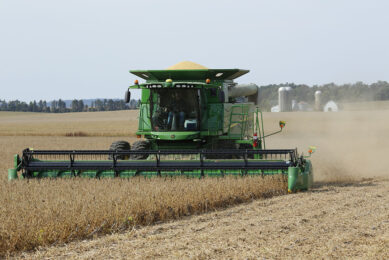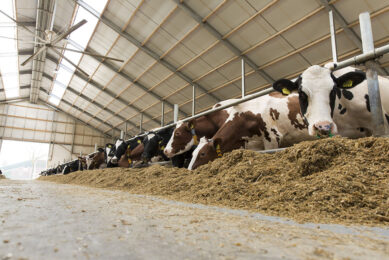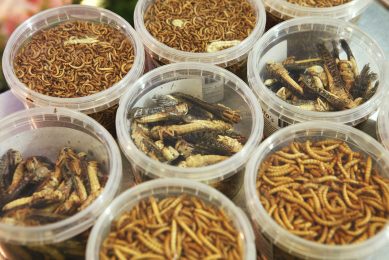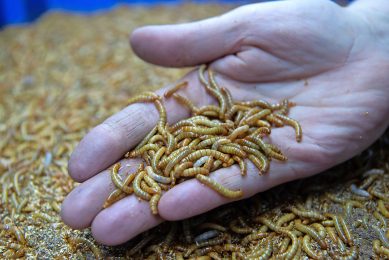EU feed autonomy requires collaboration and a multifaceted approach
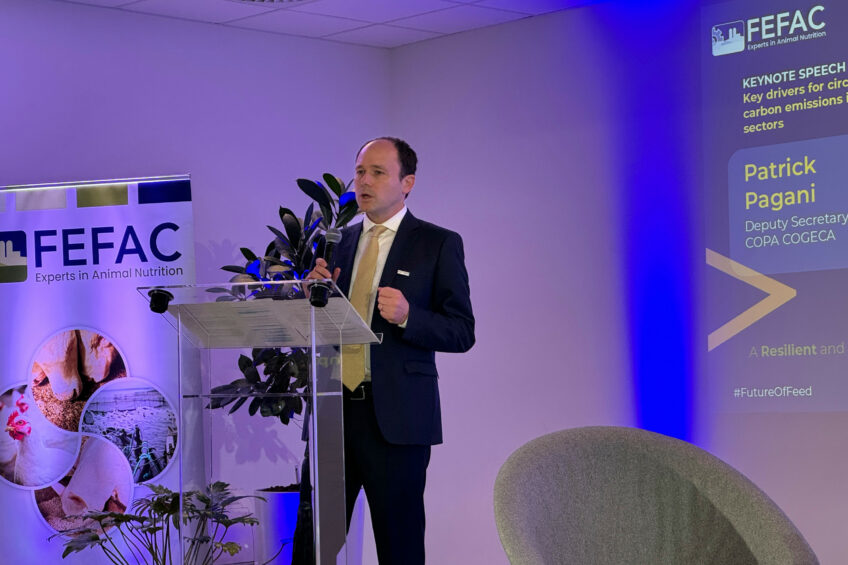
The European Feed Manufacturers’ Federation (FEFAC) held its 68th Annual Public Meeting in Brussels on 31 May. The meeting, which brought together policymakers, industry stakeholders and representatives of farmer associations, focused on feed autonomy and circularity.
Ongoing geopolitical tension has created major disruptions in EU feed and food supply chains, leaving the EU, which is heavily reliant on imports of plant protein for both animal and human consumption, struggling to meet demand.
In his opening address, FEFAC president Pedro Cordero shared 12 recommendations for the EU Strategic Agenda 2024–2029, as laid out by the federation. In order to bolster food security, FEFAC recommends the Commission to focus on policy frameworks that encourage the production of essential feed ingredients that will reduce dependency on imports and increase strategic feed autonomy, especially for feed proteins.
EU protein strategy
FEFAC recommends the EU develop national feed protein balance sheets at member state level to analyse the strengths and weaknesses of homegrown feed protein production. Finally, the federation recommends that policymakers prioritise CAP measures that boost the production of protein crops, including soybeans.
“Europe is, on average, 80% dependent, especially in the high-protein category,” said Cordero. “There we are more than 90% dependent.”
Other recommendations include investment in essential feed additive manufacturing capacity, strengthening trade partnerships to safeguard access to reliable and sustainable feed ingredients, and targeting EU research and development programmes on alternative feed sources, including algae products, single-cell proteins and fermentation biomass.
The Commission has been working on developing a protein strategy for years already. Progress has been made in terms of reducing dependency on imported protein both at EU level, as well as at national level, said Pierre Bascou, director for Sustainability and Income Support, DG Agriculture and Rural Development. Protein production in EU member states has continued to climb over the last few decades. The EU’s production of protein-rich plants, including oilseeds and dry pulses, is forecast at 7.2 million tonnes of crude protein, a growth of 28% over the last 15 years, Bascou highlighted.
Farmers income support
Some improvement came as a direct result of a 2018 report on the development of plant protein in the EU. According to Bascou, the Commission has, since that time, offered capital income support and increased subsidies for farmers who produce protein-rich crops. Results have been positive, he said. “In 20 out of 27 countries there is a possibility for farmers to receive a special payment when they grow protein crops,” said Bascou. “We are seeing that the supported area is expected to grow from 4.2 million hectares in 2022 to 6.4 million hectares in 2023 to almost 7.1 million hectares in 2027.”
Ongoing investment in research and innovation in the area of protein crops and feeding systems also aims to improve efficiency and competitiveness within the livestock sector.
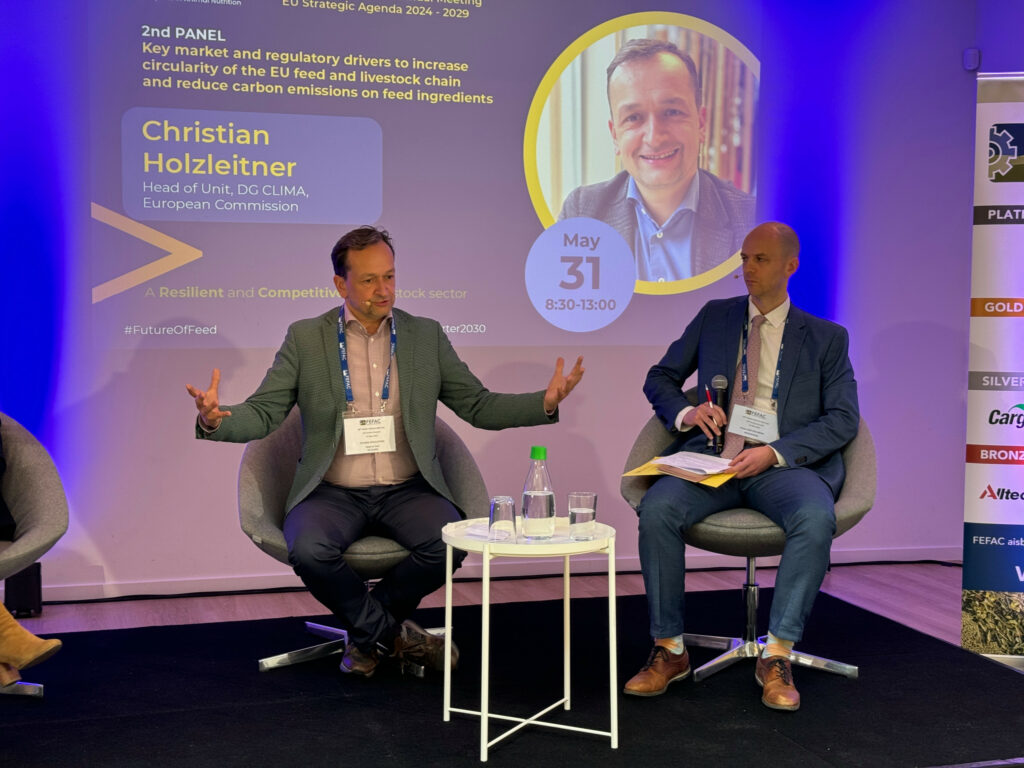
Combination of strategies needed
National strategies have had an impact as well, Bascou added, highlighting the development of mixed farms that reduce stocking density and produce their own feed. Members states should not rely on EU policy alone, he said, emphasising the need to develop strong strategies at national level.
This may be easier said than done, though, as a recent report on EU feed protein production revealed. According to the report, the EU’s dependence on imports of protein products is mainly linked to the average size of holdings, the availability of land on the continent, and the competitiveness of certain crops, such as soybeans.
Bascou concluded by saying that there is no single solution to reducing the EU’s dependency on feed imports, rather a combination of strategies will be needed to reach an acceptable level of autonomy.
Patrick Pagani, deputy secretary general, Copa-Cogeca, said that the Commission could do more, though. Policy change is too slow, he said, adding that concrete measures are needed to develop a strong protein strategy, as are research and policy around the use of residual products and food waste streams.
Andre Negreiros, business leader for Central and Eastern Europe, Corteva Agriscience, said quantitative targets are needed for protein development. Corteva is investing more than US$4 million a day to meet these targets, but real targets are needed, he said. Negreiros also made a plea for access to new genomic techniques, which he said could help speed up the development of more resilient protein crops that grow in shorter cycles, using less water.
Birthe Steenberg, secretary general of AVEC, the voice of Europe’s poultry meat sector, spoke about the group’s newly-developed sustainability pact that includes 4 ambitions, one of which is to reduce its environmental footprint. “Very close collaboration with FEFAC is necessary because 75% of the emissions from broiler production comes from the feed,” she said.
Steenberg is concerned, however, that while they’re taking one step forward in terms of lowering emissions, their new feed strategy is being undermined by another movement: the European Chicken Commitment. Slower-growing broiler breeds require more feed, but are less productive, she pointed out.
Self-sufficiency not feasible
While it is clear that strategies to improve feed circularity and availability are needed, several speakers agreed: self-sufficiency is not feasible. Erik Wibholm, director of oilseeds in Europe and the Middle East for Cargill, for instance, said he is skeptical about Europe’s ability to reduce its reliance on soy. While alternative protein options are becoming more available, soy contains key amino acids that make it very difficult to replace, he said.
FEFAC’s Cordero agreed: “We will never be 100% independent,” he said. “We should import proteins from everywhere.” But he also pointed to solutions to address the feed shortfall, such as Europe’s largest insect factory, located in Portugal, which he said could help boost protein production within the EU.
Wibholm pointed to Ukraine as a solution to the protein challenge. Europe produces about 18 million tonnes of rapeseed each year, he said, but processes 24 million tonnes, making it a net importer. Much of that tonnage comes from Australia, which has faced significant challenges in terms of drought and low production. “It’s critical that we have a pool of origins that we can pull from and Ukraine is a critical one that Europe needs,” he said.
Deforestation regulation unclear and challenging
A major topic of discussion, during the coffee break and throughout the panel discussions, was the lack of clarity on the EU’s Deforestation Regulation (EUDR). The law, which is set to come into force on 30 December, requires companies selling soy, beef, coffee, palm oil and other products to prove their supply chains do not contribute to the destruction of forests. EU companies will also be banned from exporting products grown on deforested land.
While the Commission has heard feedback from stakeholders that preparation for implementation may be challenging, a letter from EU environment commissioner Virginijus Sinkevičius, seen by Reuters and dated 2 July, affirmed its commitment to the EUDR timeline. “We are hearing feedback from some stakeholders that preparation for implementation may be challenging,” Sinkevičius wrote. “However, we also see encouraging signs in many sectors and countries working to align with EUDR requirements.”
During the FEFAC meeting, Bascou was asked about the implementation of EUDR. He ensured participants that DG Environment is “working day and night” to define guidelines to ensure the regulation is properly implemented. He said he understands the concerns raised around access to soy imports for feed. “By December of this year, I think everything will be on track, but clearly it’s a difficult challenge,” he said. “But it’s a challenge worth the commitment.”
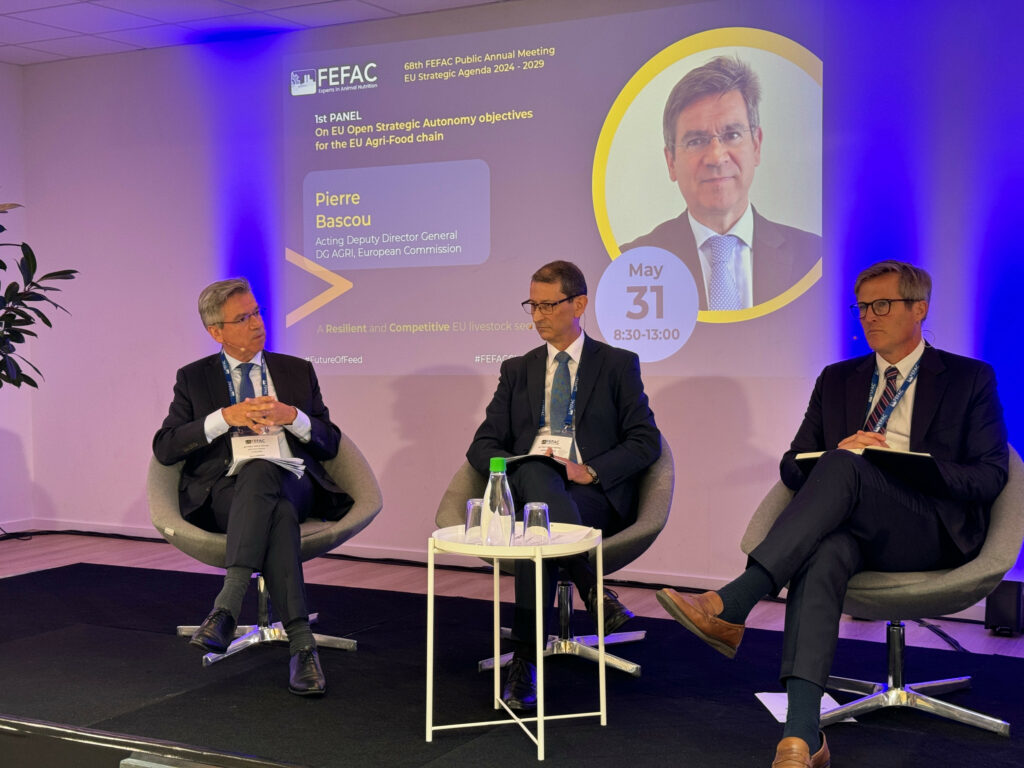
Lowering emissions and boosting circularity
The meeting’s second session was dedicated to key market and regulatory drivers needed to reduce carbon emissions and boost circularity.
Christian Holzleitner, head of unit, DG CLIMA, European Commission, highlighted the need for the agriculture sector to make further efforts to reduce carbon emissions. He stressed the Commission’s objective to integrate the livestock sector into a carbon certification framework by 2025. He said DG CLIMA is also exploring possibilities for emissions trading in the agricultural sector as part of a wider effort to stimulate the uptake of innovative business solutions.
Both Annick Pleysier, head of EMEA Public Affairs, Science & Sustainability, Crop Science Division, Bayer, and Severine Deschandelliers, FEFANA president, highlighted regulatory framework improvements that could help to remove hurdles and increase investments in farmer solutions, such as seeds, plant protection products and feed additives.
Alexander Romme, president of European Former Foodstuff Processors Association, raised awareness around some of the solutions that former foodstuffs can offer in terms of increasing circularity and reducing carbon emissions in livestock farming. He called for consistency across EU sectoral policies to ensure nutritional feed resources are not diverted to biomethane production.
FEFAC president Cordero concluded the meeting highlighting the need for industry to work together to develop the many solutions outlined by the different parts of the value chain.
“It is clear that the feed sector has a crucial role to play in supporting a vibrant European livestock sector that can improve its performance on elements such as reduced strategic import dependencies, reduced carbon emissions and increased circularity,” he concluded.




